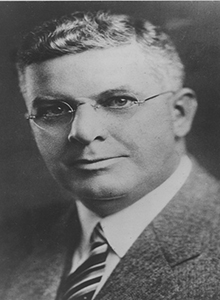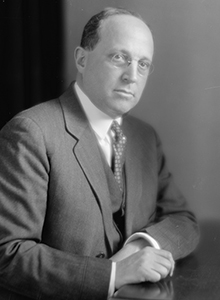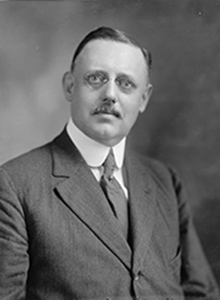
Roy A. Young
- President, Federal Reserve Bank of Boston, 1936 – 1942
- Governor, Federal Reserve Bank of Boston, 1930 – 1936
- Governor, Federal Reserve Board, 1927 – 1930
- Governor, Federal Reserve Bank of Minneapolis, 1919 – 1927
- Born: May 17, 1882
- Died: December 31, 1960
Roy A. Young's career spanned twenty-five years in three different parts of the Federal Reserve System. He was the third president at the Federal Reserve Bank of Minneapolis and the fourth president at the Federal Reserve Bank of Boston. In between his leadership terms at Reserve Banks, he led the Federal Reserve Board as governor.1
Young was born in Marquette, Michigan, in 1882. He was educated in the city's public schools, graduating from Marquette High School. At the age of eight, he began his banking career as a messenger for the First National Bank of Marquette. He later became assistant cashier at Marquette National Bank and then at his original employer, First National Bank. In 1913, he joined Citizens National Bank as a vice president.
Six years later, in 1919, Young became president of the Federal Reserve Bank of Minneapolis. Young faced a number of challenges after he took office. Postwar foreign demand for agricultural products declined, prices fell, and large numbers of banks faced disaster. While runs on banks and panics forced 20 percent of the nation's banks to close between 1921 and 1929, bank closures in the Ninth Federal Reserve District were especially high: 31 percent in Minnesota, 62 percent in North Dakota, and 70 percent in South Dakota and Montana.
In September 1927, President Coolidge appointed Young as governor of the Federal Reserve Board in Washington, DC, and Young served as governor during the stock market crash of 1929 and the early days of the Great Depression. During his Board tenure, Young focused on strengthening the banking system as opposed to influencing monetary policy. He considered the issuance of currency, rediscounting, the settlement of international transactions, and other more traditional banking activities the primary responsibilities of the Federal Reserve. He was less concerned with bringing about changes that would affect the economic environment.
In 1930, Young accepted the position of president of the Boston Fed, receiving a yearly salary of about $30,000. He served until 1942, when he resigned to become president and later chairman of the board of Merchants National Bank in Boston. Later, Young joined the board of directors of American Woolen Company, becoming chairman of the board in 1954.
Young was active in the Algonquin Club in Boston as well as the Eastern Yacht Club in Marblehead and the Cosmos Yacht Club in Washington, DC. He died in 1960, in Chestnut Hill, Massachusetts.
Endnotes
- 1 Governor was the title of the “active executive officer” of the Federal Reserve Board from 1913 to 1935. See the Board of Governors website and the essay on the Banking Act of 1935 for details on changes in the Board’s leadership structure over time.
Written by the Federal Reserve Bank of Boston and updated on October 14, 2025 by Federal Reserve History staff to clarify the historic titles used before 1935. See disclaimer and update policy.



 X
X  facebook
facebook
 email
email